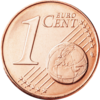Cent (currency)
A cent , pronounced [ˈ (t) sɛnt] , forms 1 ⁄ 100 of a decimal currency main unit. The name comes from the Latin centum 'hundred', probably conveyed into German from Dutch and English . The plural and genitive forms are cents for several coins per se and cents for the value.
The abbreviation is usually c , also ¢ and ct (in the plural also cts and Ct. ). A corresponding symbol (¢, Unicode number U + 00A2 ) is used in the United States of America and Canada , among others ; this is not intended for the euro .
The euro cent
The cent is one hundredth part of a euro. The designation "Cent" is specified in the EC Regulation No. 974/98 of May 3, 1998. To distinguish it from the sub-units of other currencies, it is also referred to as "Eurocent". This name is also used on the coins themselves, but in two words “Euro Cent” on top of each other with the “C” as a small capital.
The European Central Bank has not established an official abbreviation or symbol for the cent. The commonly used and generally recommended abbreviation in German is "ct". The Duden gives you the choice between "c" and "ct". In contrast, the abbreviation “Ct.” Only stands for centime . However, smaller sums are usually written as a decimal number (€ 0.99 or € - .99 instead of 99 ct).
There are separate names for the cent in the languages of most euro countries. In France , Greece , Malta , the Netherlands , Slovenia and Cyprus , they correspond to the names of the small units that were in use there just before the introduction of the euro. In some countries, the name of previous small coins was also adopted for the cent:
- Finnish sentti , if the number is more than 1 ( partitive ): senttiä
- Greek (Greece): λεπτό (leptó, plural: λεπτά leptá ) - also on the back of the Greek cent coins. It is the neuter of λεπτός leptós (thin, small, fine).
- Greek (Cyprus): σεντ (sent)
- French (France): centime (plural: centimes )
- Italian centesimo (plural: centesimi )
- Portuguese cêntimo (plural: cêntimos )
- Slovenian stotin (plural: stotini , in connection with the numbers 2 to 4: stotina [= dual or genitive singular], in connection with numbers from 5: stotinov [= genitive plural])
- Spanish céntimo (plural: céntimos ), on the recommendation of the Real Academia Española
There are euro coins in circulation with a value of 1, 2, 5, 10, 20 and 50 cents, and other values were issued as collector coins (40, 700 cents).
In Finland and the Netherlands, the one and two cent coins are not in circulation. The amount to be paid is always rounded to 5 cents at the checkout. If, on the other hand, you pay cashless , for example by card, the exact amount is debited and not rounded.
The dollar cents
There are more than 20 currencies called "dollars" around the world. Their hundredth currencies are generally called cent / cent, with the plural being either cent / cent or cents / cents.
Other countries
In addition to the euro and dollar currencies, the cent is also a sub-unit of the following currencies:
- Antilles guilder
- Aruba florin
- Eritrean Nakfa
- Kenyan shilling
- Lilangeni (Swaziland)
- Mauritian rupee
- Seychelles rupee
- Sierra Leonean Leone
- Sri Lankan rupee
- South African rand
- Tanzanian Shilling
- Uganda shilling
The cent used to exist in the Netherlands ( guilder , until 1998/2001), in Malta ( lira , until 2007) and the Republic of Cyprus ( pound , until 2007). To distinguish it from the old cents, in the Netherlands the new cents are often expressly referred to as euro cents .
In Suriname , cent was already the name for a hundredth of the Suriname guilder , the predecessor of the Suriname dollar that is valid today .
In Costa Rica the "¢" symbol is often used instead of the "₡" - currency symbol for Costa Rican Colón .
Related terms
Other names for 1 ⁄ 100 of a currency unit , also derived from the Latin centum , are:
- Centavo in many Spanish and Portuguese speaking countries
- Centas in Lithuania until 2014, subunit of the litas
- Centesimo in Spanish- (Centésimo) and Italian-speaking countries, among other things as the Italian name for the Swiss black horse
- Centime in French-speaking countries
- Centimo in many Spanish (Céntimo) and Portuguese-speaking (Cêntimo) countries
- Santim in Ethiopia, subunit of the Birr
- Santīms in Latvia until 2013, subunit of the lat
- Sen in Asian countries
- Senti in Somalia, sub-unit of the Somalia shilling , and until 2010 in Estonia, sub-unit of the crown
Web links
Individual evidence
- ↑ Helmut Kahnt, Bernd Knorr: Old dimensions, coins and weights. A lexicon. Bibliographisches Institut, Leipzig 1986, licensed edition Mannheim / Vienna / Zurich 1987, ISBN 3-411-02148-9 , pp. 375-380.
- ↑ Regulation (EC) No. 974/98 of the Council of May 3, 1998 on the introduction of the euro . In: Official Journal. No. L 139 of May 11, 1998 pp. 1-5.
- ↑ Diccionario panhispánico de dudas (Pan-Hispanic Dictionary of Doubt)
- ^ Currencies of the World. Retrieved May 22, 2017 (English).
- ↑ Currency Facts | OANDA. Retrieved May 22, 2017 (English).
- ↑ Kevin Steiner: Money of the World: Currency Eritrea - the Eritrean Nakfa . In: Money Worlds . ( geld-welten.de [accessed on May 22, 2017]).

